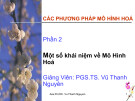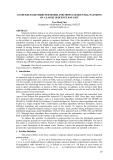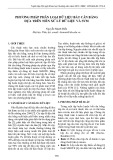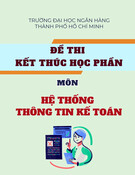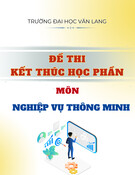1
Feature engineering
2
Feature engineering
• "Feature engineering is the process of transforming
3
raw data into features that better represent the underlying problem to the predictive models, resulting in improved model accuracy on unseen data." – Jason Brownlee
Feature engineering
• “Coming up with features is difficult, time-consuming,
4
requires expert knowledge. 'Applied machine learning' is basically feature engineering.” – Andrew Ng
The dream ...
Datas et
Mod el
Tas k
Raw data
5
… The Reality
?
?
Features
Task
Model
ML Ready dataset
Raw data
Feature engineering toolbox
• Just kidding :)
Variable data types
8
Number variables
9
Binarization
• Counts can quickly accumulate without bound
• convert them into binary values (0, 1) to indicate
10
presence
Quantization or Binning
• Group the counts into bins
• Maps a continuous number to a discrete one
• Fixed-width binning
• Eg.
• 0–12 years old • 12–17 years old • 18–24 years old • 25–34 years old
• Adaptive-width binning
11
• Bin size
Equal Width Binning
• divides the continuous variable into several categories
having bins or range of the same width
• easy to compute
• Pros
• large gaps in the counts • many empty bins with no data
12
• Cons
Adaptive-width binning
• Quantiles: values that divide the data into equal portions
(continuous intervals with equal probabilities)
• Some q-quantiles have special names
• The only 2-quantile is called the median • The 4-quantiles are called quartiles → Q • The 6-quantiles are called sextiles → S • The 8-quantiles are called octiles • The 10-quantiles are called deciles → D
13
• Equal frequency binning
Example: quartiles
14
Log Transformation
• Original number = x
• Transformed number
x'=log10(x)
• Backtransformed number =
10x'
15
Box-Cox transformation
16
Feature Scaling or Normalization
• Models that are smooth functions of the input, such as
linear regression, logistic regression are affected by the scale of the input
• Feature scaling or normalization changes the scale of
17
the features
Min-max scaling
● Squeezes (or stretches) all values within the range of [0, 1] to add robustness to
very small standard deviations and preserving zeros for sparse data.
• >>> from sklearn import preprocessing
• >>> X_train = np.array([[ 1., -1., 2.],
• ...
[ 2., 0., 0.],
• ...
[ 0., 1., -1.]])
• ... • >>> min_max_scaler =
preprocessing.MinMaxScaler()
• >>> X_train_minmax =
min_max_scaler.fit_transform(X_train)
array([[ 0.5
],
[ 1. [ 0.
, 0. , 0.5 , 1.
, 1. , 0.33333333], , 0.
]])
Standard (Z) Scaling
After Standardization, a feature has mean of 0 and variance of 1 (assumption of
many learning algorithms)
>>> from sklearn import preprocessing >>> import numpy as np >>> X = np.array([[ 1., -1., 2.], [ 2., 0., 0.], ... [ 0., 1., -1.]]) ... >>> X_scaled = preprocessing.scale(X) >>> X_scaled array([[ 0. ..., -1.22..., 1.33...], [ 1.22..., 0. ..., -0.26...], [-1.22..., 1.22..., -1.06...]])
>> X_scaled.mean(axis=0) array([ 0., 0., 0.]) >>> X_scaled.std(axis=0) array([ 1., 1., 1.])
Standardization with scikit-learn
l2 Normalization
• also known as the Euclidean norm
from pandas import read_csv from numpy import set_printoptions from sklearn.preprocessing import Normalizer path = r’./pima-indians-diabetes.csv’ names = ['preg', 'test', 'mass', 'pedi', 'age', 'class’] dataframe = read_csv (path, names=names) array = dataframe.values Data_normalizer = Normalizer(norm='l2').fit(array) Data_normalized = Data_normalizer.transform(array)
20
• measures the length of the vector in coordinate space
Categorical Variables
21
Categorical Features
• Nearly always need some treatment to be suitable for
models
• High cardinality can create very sparse data
• Difficult to impute missing
• Platform: [“desktop”, “tablet”, “mobile”] • Document_ID or User_ID: [121545, 64845, 121545]
• Examples
Label Encoding
• transform categorical variables into numerical variables
23
by assigning a numerical value to each of the categories
LabelCount encoding
• Rank categorical variables by count in train set
• Useful for both linear and non-linear algorithms (eg:
decision trees)
• Not sensitive to outliers
• Won’t give same encoding to different variables
Ordinal encoding
• transform an original categorical variable to a
25
numerical variable by ensuring the ordinal nature of the variables is sustained
Frequency encoding
• transform an original categorical variable to a
26
numerical variable by considering the frequency distribution of the data
Binary encoding
• transform an original categorical variable to a
numerical variable by encoding the categories as Integer and then converted into binary code
• This method is preferable for variables having a large
27
number of categories
One hot encoding
28
• creates k different columns each for a category and replaces one column with 1 rest of the columns is 0
Target Mean encoding
• one of the best
techniques
• replace the categorical variable with the mean of its corresponding target variable • Steps for mean
• For each category • Calculate aggregated
sum (= a)
• Calculate aggregated
total count (= b)
• Numerical value for that
category = a/b
29
encoding
Feature Hashing
Some large categorical features from Outbrain Click Prediction competition
30
• Dealing with Large Categorical Variables
Feature hashing [2]
• Hashes categorical values into vectors with fixed-length.
• Lower sparsity and higher compression compared to OHE
• Deals with new and rare categorical values (eg: new user-agents)
• May introduce collisions
100 hashed columns
Bin-counting
• Instead of using the value of the categorical variable as the feature, we compute the association statistics between that value and the target that we wish to predict
• Useful for both linear and non-linear algorithms
• May give collisions (same encoding for different
categories)
o r
o r
• Be careful about leakage
• Strategies • Count • Average CTR
Counts
Click-Through Rate
P(click | ad) = ad_clicks / ad_views
Text Data
33
Natural Language Processing
• Removing • Stopwords • Rare words • Common words
• Cleaning • Lowercasing • Convert accented characters • Removing non-alphanumeric • Repairing
• Roots • Spelling correction • Chop • Stem • Lemmatize
• Tokenizing • Encode punctuation marks • Tokenize • N-Grams • Skip-grams • Char-grams • Affixes
• Enrich • Entity Insertion / Extraction • Parse Trees • Reading Level
Text vectorization
• Represent each document as a feature vector in the
• BoW (Bag of words) • TF-IDF (Term Frequency - Inverse Document Frequency) • Embeddings (eg. Word2Vec, Glove) • Topic models (e.g LDA)
vector space, where each position represents a word (token) and the contained value is its relevance in the document.
Document Term Matrix - Bag of Words
Bag-of-Words
• “Customer reviews build something known as social proof, a
phenomenon that states people are influenced by those around them. This might include friends and family, industry experts and influencers, or even internet strangers.”
• Input
• a text document is converted into a “flat” vector of counts • doesn’t contain any of the original textual structures • John is quicker than Mary and Mary is quicker than John have
the same vectors
36
• Output
Bag-of-n-Grams
• a natural extension of bag-of-words (a word is
essentially an unigram)
• bag-of-n-grams representation can be more
• n-grams retain more of the original sequence structure
informative
• bag-of-n-grams is a much bigger and sparser feature space
37
• Cons
From Words to n-Grams to Phrases
• Tokenization is the process of tokenizing or splitting a
string, text into a list of tokens.
• Chunking a sentences refers to breaking/dividing
38
a sentence into parts of words such as word groups and verb groups.
Document frequency
• Recall stop words
• Rare terms are more informative than frequent terms
• Consider a term in the query that is rare in the
collection (e.g., arachnocentric)
• A document containing this term is very likely to be
• → We want a high weight for rare terms like arachnocentric.
39
relevant to the query arachnocentric
Tf-idf
• The term frequency tft,d of term t in document d is defined as the number of times that t occurs in d. • dft is the document frequency of t: the number of
• dft is an inverse measure of the informativeness of t • dft £ N
documents that contain t
idf
(
N
/df
)
log =
t
t
10
• We use log (N/dft) instead of N/dft to “dampen” the effect of idf.
40
• We define the idf (inverse document frequency) of t by
Tf-idf
• The tf-idf weight of a term is the product of its tf weight
w
log( 1
tf
)
log
(
N
=
+
´
)df/ t
10
dt ,
dt ,
and its idf weight.
• Note: the “-” in tf-idf is a hyphen, not a minus sign! • Alternative names: tf.idf, tf x idf
• Best known weighting scheme in information retrieval
• Increases with the number of occurrences within a
document
41
• Increases with the rarity of the term in the collection
Filtering for Cleaner Features
• weeding out common words that make for vacuous features
• Stopwords
• filtering out corpus-specific common words as well as general-
purpose stopwords
• Frequency-Based Filtering
• Depending on the task, one might also need to filter out rare
words.
• These might be truly obscure words, or misspellings of
common words.
• Rare words
• An NLP task that tries to chop each word down to its basic
linguistic word stem form
42
• Stemming
Word representation: embedding the context
• Attempt to encode similarity inside the word vectors
• “You shall know a word by the company it keeps” (J. R. Firth
1957)
During his presidency, Trump ordered a travel ban on citizens controversial or false. Trump was elected president in a surprise victory over 1971, renamed it to The Trump Organization, and expanded it into Manhattan.
coordination between the Trump campaign and the Russian government in its election interference.
These words describe the meaning of Trump
3/6/21
43
• Built ontop of the following great idea
Word embedding
• Each word is encoded in a dense vector (Low
dimension)
University =
0.13 0.67 - 0.34 0.76 - 0.21 -0.11 - 0.45 0.87 0.44
3/6/21
44
• Able to capture the semantics • Similar words ~ Similar vectors
How to learn word embeddings
• The famous approach: Word2vec (Mikolov et. al. 2013)
• Unsupervised learning
• Large-scale dataset
• Lower computation cost
© Mikolov et. Al. 2013
3/6/21
45
• High quality word vectors
BERT sentence embedding
• Feng, Fangxiaoyu, et al. "Language-agnostic BERT
46
Sentence Embedding." arXiv preprint arXiv:2007.01852 (2020).
Feature selection
47
Interaction Features
• A simple pairwise interaction feature is the product of
two features
• A simple linear model • y=w1x1 +w2x2 +...+wnxn
• An easy way to extend the linear model is to include
• y = w1x1 + w2x2 + ... + wnxn + w1,1x1x1 + w1,2x1x2 + w1,3x1x3 + ...
48
combinations of pairs of input features
Polynomial Features
>>> import numpy as np >>> from sklearn.preprocessing import PolynomialFeatures >>> X = np.arange(6).reshape(3, 2) >>> X array([[0, 1], [2, 3], [4, 5]])
>>> poly = poly = PolynomialFeatures(degree=2, interaction_only=False, include_bias=True) >>> poly.fit_transform(X) array([[ 1., 0., 1., 0., 0., 1.], [ 1., 2., 3., 4., 6., 9.], [ 1., 4., 5., 16., 20., 25.]])
Polynomial features with scikit-learn
Feature Selection
• prune away nonuseful features in order to reduce the
complexity of the resulting model
• Objective
• Training a machine learning algorithm faster. • Reducing the complexity of a model and making it easier
to interpret.
• Building a sensible model with better prediction power. • Reducing overfitting by selecting the right set of features.
50
• Advantages
Wrapper methods
• The feature selection process is based on a specific
machine learning algorithm
• Exhaustive search follows a greedy search
approach by evaluating all the possible combinations of features against the evaluation criterion
• Random search methods randomly generate a subset
of features
• Computationally intensive since for each subset a new
51
model needs to be trained
Embedded Methods
• Perform feature selection during the model training
• select a feature in each recursive step of the tree growth process and divide the sample set into smaller subsets
• The more child nodes in a subset are in the same class, the
more informative the features are
52
• Decision tree
Method comparision
53
“More data beats cleveralgorithms, but better data beats moredata.”
– Peter Norvig
Diverse set of features and models leads to different results!
Outbrain Click Prediction
Towards Automated Feature Engineering
Deep Learning....
Thank you for your attention!!!
57
References
• Scikit-learn -
Preprocessing data
• Spark ML - Feature
extraction
Temporal Features
Time Zone conversion
• Factors to consider: ● Multiple time zones in some countries ● Daylight Saving Time (DST) ○ Start and end DST dates
Time binning
● Apply binning on time data to make it categorial and more
general.
● Binning a time in hours or periods of day, like below.
Hour range
Bin ID
Bin Description
[5, 8)
1
Early Morning
[8, 11)
2
Morning
[11, 14)
3
Midday
[14, 19)
4
Afternoon
[19, 22)
5
Evening
[22-24) and (00-05]
6
Night
● Extraction: weekday/weekend, weeks, months, quarters, years...
Closeness to major events
• Hardcode categorical features from dates
• Example: Factors that might have major influence on
spending behavior
• Proximity to major events (holidays, major sports
• Eg. date_X_days_before_holidays
events)
• Eg. first_saturday_of_the_month
• Proximity to wages payment date (monthly seasonality)
Time differences
• Differences between dates might be relevant
• user_interaction_date - published_doc_date
• Examples:
• last_user_interaction_date - user_interaction_date • To model how old was a given user interaction
• To model how recent was the ad when the user viewed it. Hypothesis: user interests on a topic may decay over time
compared to his last interaction
Spatial Features
Spatial Variables
• GPS-coordinates (lat. / long.) - sometimes require projection
to a different coordinate system
• Street Addresses - require geocoding • ZipCodes, Cities, States, Countries - usually enriched with the centroid coordinate of the polygon (from external GIS data)
• Spatial variables encode a location in space, like:
• Distance between a user location and searched hotels
(Expedia competition)
• Impossible travel speed (fraud detection)
• Derived features
Spatial Enrichment
• Usually useful to enrich with external geographic data
Beverage Containers Redemption Fraud Detection: Usage of # containers redeemed (red circles) by store and Census households median income by Census Tracts
(eg. Census demographics)

